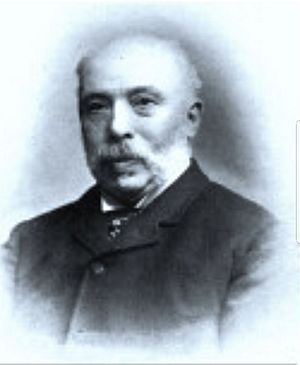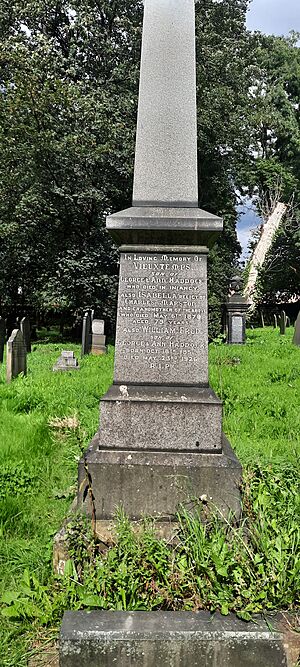George Haddock (musician) facts for kids
Quick facts for kids
George Haddock
|
|
|---|---|

George Haddock
|
|
| Background information | |
| Birth name | George Haddock |
| Born | 7 August 1823 |
| Origin | Killingbeck, Leeds |
| Died | 12 September 1907 (aged 84) Leeds |
| Genres | Classical |
| Occupation(s) | Musician |
| Instruments | Violin |
George Haddock (born August 7, 1823 – died September 12, 1907) was a famous English violinist and music teacher. He was born in Killingbeck, Leeds. George was a very important person in the music world of Leeds and Bradford in the mid to late 1800s. In 1894, he started the Leeds College of Music, which is now known as Music House.
Contents
Biography
Early Life and Musical Journey
George Haddock grew up in a family that loved music. Most of his family members played instruments. His brother, Thomas Haddock, was a cello player. Thomas played in music groups with famous musicians like Paganini and Mendelssohn.
Other well-known musicians, such as Ole Bull, also visited their home. These visits greatly inspired young George. He soon decided to learn the violin.
At first, his family wanted him to become a lawyer. George even started working with a lawyer in Leeds. But it quickly became clear that he didn't want to be a lawyer. So, his family let him go back to studying music.
His first music teacher was Mr. R.A. Brown in Leeds. Later, he studied with other great violinists like Joseph Bywater, Henri Vieuxtemps, and Bernhardt Molique.
Friendship with Henri Vieuxtemps
George first met the famous violinist Henri Vieuxtemps in 1846. Henri was visiting Leeds at the time. George asked his friends to help him meet Vieuxtemps so he could play for him.
After this meeting, Vieuxtemps gave George violin lessons. They became very close friends. George even took Vieuxtemps' wife to all of his concerts in London in 1846. Their friendship grew stronger over the years. Whenever Vieuxtemps visited Leeds, he would stay at George's house.
George even named one of his sons, Vieuxtemps Haddock, after his good friend. He also wrote a book and dedicated a chapter in it to Henri Vieuxtemps.
Later Life and Teaching
As he got older, George Haddock became a well-known music professor by 1853. He taught the violin to more than 4,000 students. One of his most famous students was the composer Frederick Delius.
In 1894, George started the Leeds College of Music. After he passed away in 1907, his sons, Edgar and George Percy Haddock, took over as the directors of the college.
George's Amazing Collection
George Haddock had a huge collection of musical instruments. He owned many violins and bows. He had been collecting them for over 45 years when he died.
Here are some of the famous violins that were part of George Haddock’s collection:
- Violin, 1695, by Carlo Giuseppe Testore
- 'Ford' Violin, 1703, by Antonio Stradivari
- 'Haddock' Violin, 1734, by Bartolomeo Giuseppe Guarneri
- 'Emperor, Gillott, Kubelik', Violin, 1715, by Antonio Stradivari
- 'Haddock, Cater, Rostal' Violin, 1697, by Antonio Stradivari
- 'Drummond Amati' Violin, 1694, by Francesco Rugeri
- Violin, by Giuseppe Guarneri
- 'Castelbarco, Haddock, Bromley Booth, Tarisio' Violin, 1730-34, by Bartolomeo Giuseppe Guarneri
He also owned a 1673 Rugerius violin and a 1615 Antonio Amati violin. In 1890, he thought he had over 80 violins!
His collection of bows was also very special. It was called "undoubtedly the largest and most valuable collection of bows in the world." Many of these bows were made by François Tourte, a famous bow maker.
In his book, George shared a story about the 'Emperor' Stradivarius violin, which he bought in 1876. He also wrote about the 'Lady Hallé, Ernst' violin.
A man named Andrew Fountaine owned both of these violins in the early 1800s. He kept them in a special double case. When he heard Heinrich Wilhelm Ernst play the 'Lady Hallé, Ernst' violin, Mr. Fountaine gave the violin to him as a gift. Ernst showed this violin to George in 1852.
After Ernst died, the violin was owned by a few different people. Then, around 1872, Wilma Neruda, who was married to Charles Hallé, chose the violin. She tried it out for a month. Her first big concert with the violin was at St. George’s Hall in Bradford. Hallé asked George to listen to how the violin sounded from different parts of the hall. George said, "It sounded wonderful and if Madame Neruda does not decide to have it, I shall." Because of George's opinion, they decided to keep the violin.
Personal Life
George Haddock married Ann Marston in 1844. They had seven children together. George passed away on September 12, 1907. He is buried in Beckett Street Cemetery in Leeds.


